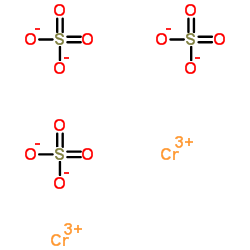10101-53-8
| 中文名 | 硫酸铬 |
|---|---|
| 英文名 | chromium(III) sulfate |
| 英文别名 |
EINECS 233-253-2
Chromic sulfate MFCD00016039 |
| 密度 | 1.3614 g/ml |
|---|---|
| 沸点 | 330ºC at760mmHg |
| 分子式 | Cr2O12S3 |
| 分子量 | 392.180 |
| 精确质量 | 391.736206 |
| PSA | 265.92000 |
| 外观性状 | 绿色或紫罗兰色晶体 |
| 储存条件 | 1.库房低温, 通风, 干燥 ; 防火; 与强氧化剂分开存放 |
| 稳定性 | 1.不可燃物质; 受热分解有毒铬化物和硫氧化物烟雾. 2.无水物呈紫色或红色, 相对分子质量392.24, 相对密度3.012, 不溶于水和酸。十五水合硫酸铬呈深绿色, 相对分子质量662.38 相对密度1.867, 溶于水。十八水合硫酸铬呈紫色, 相对分子质量716.43, 相对密度1.70, 溶于水和乙醇 |
| 水溶解性 | 每100毫升水中的溶解克数: 220g/20℃ |
| 计算化学 | 1.疏水参数计算参考值(XlogP):无 2.氢键供体数量:0 3.氢键受体数量:12 4.可旋转化学键数量:0 5.互变异构体数量:无 6.拓扑分子极性表面积266 7.重原子数量:17 8.表面电荷:0 9.复杂度:62.2 10.同位素原子数量:0 11.确定原子立构中心数量:0 12.不确定原子立构中心数量:0 13.确定化学键立构中心数量:0 14.不确定化学键立构中心数量:0 15.共价键单元数量:5 |
| 更多 | 1.性状:墨绿色的鳞片状结晶或绿色粉末。 2..溶解性:溶于水,难溶于醇。 |
Synonym:Chromic sulfate; dichromium sulfate; sulfuric acid chromium sal Section 2 - COMPOSITION, INFORMATION ON INGREDIENTS
Risk Phrases: 36/37/38 Section 3 - HAZARDS IDENTIFICATION EMERGENCY OVERVIEW
Irritating to eyes, respiratory system and skin. Potential Health Effects Eye: Causes eye irritation. Skin: Causes skin irritation. May cause skin sensitization, an allergic reaction, which becomes evident upon re-exposure to this material. Ingestion: Causes gastrointestinal irritation with nausea, vomiting and diarrhea. Inhalation: Causes respiratory tract irritation. Chronic: No information found. Section 4 - FIRST AID MEASURES Eyes: Flush eyes with plenty of water for at least 15 minutes, occasionally lifting the upper and lower eyelids. If irritation develops, get medical aid. Skin: Get medical aid. Flush skin with plenty of water for at least 15 minutes while removing contaminated clothing and shoes. Ingestion: If victim is conscious and alert, give 2-4 cupfuls of milk or water. Get medical aid. Inhalation: Remove from exposure and move to fresh air immediately. If not breathing, give artificial respiration. If breathing is difficult, give oxygen. Get medical aid. Notes to Physician: Section 5 - FIRE FIGHTING MEASURES General Information: As in any fire, wear a self-contained breathing apparatus in pressure-demand, MSHA/NIOSH (approved or equivalent), and full protective gear. During a fire, irritating and highly toxic gases may be generated by thermal decomposition or combustion. Runoff from fire control or dilution water may cause pollution. Extinguishing Media: Substance is noncombustible; use agent most appropriate to extinguish surrounding fire. Section 6 - ACCIDENTAL RELEASE MEASURES General Information: Use proper personal protective equipment as indicated in Section 8. Spills/Leaks: Vacuum or sweep up material and place into a suitable disposal container. Clean up spills immediately, observing precautions in the Protective Equipment section. Avoid generating dusty conditions. Provide ventilation. Section 7 - HANDLING and STORAGE Handling: Minimize dust generation and accumulation. Avoid contact with skin and eyes. Keep container tightly closed. Avoid ingestion and inhalation. Use with adequate ventilation. Storage: Store in a cool, dry place. Store in a tightly closed container. Section 8 - EXPOSURE CONTROLS, PERSONAL PROTECTION Engineering Controls: Facilities storing or utilizing this material should be equipped with an eyewash facility and a safety shower. Use adequate general or local exhaust ventilation to keep airborne concentrations below the permissible exposure limits. Exposure Limits CAS# 10101-53-8: Personal Protective Equipment Eyes: Wear appropriate protective eyeglasses or chemical safety goggles as described by OSHA's eye and face protection regulations in 29 CFR 1910.133 or European Standard EN166. Skin: Wear appropriate protective gloves to prevent skin exposure. Clothing: Wear appropriate protective clothing to minimize contact with skin. Respirators: Follow the OSHA respirator regulations found in 29 CFR 1910.134 or European Standard EN 149. Use a NIOSH/MSHA or European Standard EN 149 approved respirator if exposure limits are exceeded or if irritation or other symptoms are experienced. Section 9 - PHYSICAL AND CHEMICAL PROPERTIES Physical State: Solid Color: green to violet to red Odor: odorless pH: 1.0-2.5 5% solution Vapor Pressure: Negligible. Viscosity: Not applicable. Boiling Point: Not available. Freezing/Melting Point: Not available. Autoignition Temperature: Not available. Flash Point: Not available. Explosion Limits, lower: Not available. Explosion Limits, upper: Not available. Decomposition Temperature: Not available. Solubility in water: Soluble in water. Specific Gravity/Density: 1.7-3.0 Molecular Formula: Cr2(SO4)3.nH2O Molecular Weight: 392.1648 Section 10 - STABILITY AND REACTIVITY Chemical Stability: Stable under normal temperatures and pressures. Conditions to Avoid: None reported. Incompatibilities with Other Materials: Hydrogen gas may be evolved from moist chromic sulfate. If damp material is sealed for a prolonged period of time, the container may rupture because of the pressure of hydrogen. Reacts violently with reducing agents, combustibles, ammonia, halides, phosphorous, sodium azide, elemental sulfur and urea. Hazardous Decomposition Products: Oxides of sulfur, irritating and toxic fumes and gases. Hazardous Polymerization: Has not been reported. Section 11 - TOXICOLOGICAL INFORMATION RTECS#: CAS# 10101-53-8: GB7200000 LD50/LC50: Not available. Carcinogenicity: Chromium (III) Sulfate Hydrate - Not listed by ACGIH, IARC, or NTP. Other: See actual entry in RTECS for complete information. Section 12 - ECOLOGICAL INFORMATION Section 13 - DISPOSAL CONSIDERATIONS Products which are considered hazardous for supply are classified as Special Waste and the disposal of such chemicals is covered by regulations which may vary according to location. Contact a specialist disposal company or the local waste regulator for advice. Empty containers must be decontaminated before returning for recycling. Section 14 - TRANSPORT INFORMATION IATA No information available. IMO No information available. RID/ADR No information available. USA RQ: CAS# 10101-53-8: 1000 lb final RQ; 454 kg final RQ Section 15 - REGULATORY INFORMATION European/International Regulations European Labeling in Accordance with EC Directives Hazard Symbols: XI Risk Phrases: R 36/37/38 Irritating to eyes, respiratory system and skin. Safety Phrases: S 24/25 Avoid contact with skin and eyes. WGK (Water Danger/Protection) CAS# 10101-53-8: 1 Canada CAS# 10101-53-8 is listed on Canada's DSL List. CAS# 10101-53-8 is listed on Canada's Ingredient Disclosure List. US FEDERAL TSCA CAS# 10101-53-8 is listed on the TSCA inventory. SECTION 16 - ADDITIONAL INFORMATION N/A |
|
毒理学数据: 静脉-小鼠 LDL0: 85 毫克/公斤 CHEMICAL IDENTIFICATION
HEALTH HAZARD DATAACUTE TOXICITY DATA
MUTATION DATA
|
| 安全声明 (欧洲) | S24/25 |
|---|---|
| 危险品运输编码 | UN 9100 |
| 海关编码 | 2833292000 |
| 海关编码 | 2833292000 |
|---|



